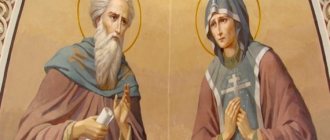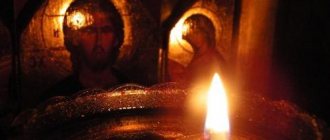Saints Athanasius the Great, Cyril of Alexandria, archbishops
Saint Athanasius was born in Alexandria; his mother, like Anna, who brought her son Samuel to the temple of the Lord (1 Samuel 1:28), also brought him to St. Alexander, Patriarch of Alexandria, and gave it to the temple to serve God. And he began to spend his life at the temple, zealously fulfilling the commandments of God.
In 319, the patriarch ordained him a deacon of the Alexandrian Church. Already at this time, Saint Athanasius began to write essays. The future saint saw that the newcomers to the Church of Christ had no zeal, they had no true piety, many of them sought glory for themselves, talked idle talk, idle talk, and transferred all the pagan customs that they had before into Christian life. A certain Arius appeared who blasphemed Christ, humiliated the Mother of God and outraged the people, teaching the people to achieve honor, glory, to penetrate the Church, to achieve the priesthood and even the bishopric. And many listened to him and became followers of this heresy - Arians. And this heresy spread so much that it almost overwhelmed the entire Church - there was a great war. In 325, Saint Athanasius was at the Council of Nicaea, where he spoke out against Arius.
In 326, after the death of Patriarch Alexander, Saint Athanasius was elected to the See of Alexandria. As bishop, Athanasius toured churches, spoke a lot, fought against the Arians, wrote, denounced them, and all the untrue Christians rebelled against him and began to slander him. At that time, Constantine the Great reigned (306–337), he was considered the patron of the Church of Christ. He understood military strategy, diplomacy, and state affairs well, but he did not know church affairs or preaching the Gospel, so he hesitated between Arianism and Orthodoxy.
Taking advantage of the kindness and simplicity of the emperor, heretics surrounded his entire court, penetrated all positions and began to whisper heresies and untruths and introduce schisms. They accused Archbishop Athanasius that he was a bad person, that he did not obey the king, that he collected taxes separately from the royal treasury and committed bad deeds, that he was a sorcerer, a criminal, and a fornicator. The emperor saw great strife, enmity, tried to establish peace, but there were times when war could break out, then he suggested that Saint Athanasius retire somewhere for a while. And the saint spent most of his long reign in exile, and then he often enjoyed the support of the monks, and was in friendship with both fathers of monasticism - the holy monks Anthony and Pachomius.
Heretics and evil people especially tried to accuse Saint Athanasius of not listening to the commands of the emperor, not paying attention to his instructions, not accepting Arius into church communion, that he was a sorcerer and sorcerer, being himself obvious sorcerers, and that through some kind of then the dead hand, supposedly belonging to the cleric Arseny, performs enchantments. The Emperor ordered an investigation. Arseny was a cleric, a reader, having committed some kind of offense, he hid for a long time, and when rumors about this began to spread everywhere, he developed a sense of truth and justice, because Saint Athanasius of Christ was innocent, and Arseny himself was not harmed at all, It was not his hand that was cut off, it was another man who was found somewhere by evil judges, although many of them were bishops. Condolent for his father and benefactor and grieving in his heart that truth was being lawlessly conquered by lies, he secretly came to Athanasius himself, falling at his honest feet. Blessed Athanasius, rejoicing at the arrival of Arseny, ordered him not to show himself to anyone until the trial.
Meanwhile, the evil hatred of Athanasius’ opponents increased so much that to one lie they added a new one: they bribed one shameless woman to slander Saint Athanasius, saying that he had committed iniquity with her. When the trial began, the judges sat down in their places and the slanderers appeared, and this woman was brought in. With tears she complained for a long time about the saint, whom she had never seen and did not even know what he looked like. Everyone listened in bewilderment. But she didn’t even want to know the piety of the Gospel, rejoicing that they gave her a lot of money. At that time, Athanasius’s friend Presbyter Timothy, standing with him outside the doors and hearing everything, was indignant in spirit and, unexpectedly entering the courthouse, hastily stood before the eyes of that slanderer, as if he were Athanasius himself; he boldly turned to her: “Did I commit violence against you at night, as you say?” And she cried out to the judges even more shamelessly: “This, this man is my corrupter and attacker against my purity; he...” The judges laughed when they saw the meanness, the comedy played, and drove her away. But the opponents of St. Afanasy, although they were ashamed, did not calm down and began to accuse him of killing Arseny, showing some kind of terrible-looking dead hand. Saint Athanasius patiently listened to them and was silent, then asked: “Are there any among you who knew Arseny well? How many of you can confirm whether this is really his hand? And most of the unrighteous judges stood up, jumped up and began to claim that this was indeed the hand of Arseny. And then, when they showed their dirty heart and their deceit, the saint pulled back the curtain behind which Arseny stood, brought him out in front of the meeting and asked: “Who is this standing before you? You said that Arseny is no longer alive, this is his hand.” And everyone was horrified. “Here, men, is Arseny! - announced Saint Athanasius. - Here are his hands, which were not cut off at all! Show us your Arseny, if you have one, and tell who owns the severed hand that condemns you as having committed this crime.” But the judges continued to hold court, exhausting all their slander. And Saint Athanasius, unable to bear the injustice being committed, testified aloud to the entire council: “Truth has faded away, truth has been trampled upon, justice has perished, legal investigation and careful consideration of cases have disappeared from the judges! Is it legal for someone who wants to justify himself to be kept in prison, and the trial of the entire case to be entrusted to slanderers and enemies, and for the slanderers themselves to judge the one who is being slandered?” The saint was acquitted by the emperor and sent to his See of Alexandria.
When Constantine the Great died and his second son Constantius took the throne, the entire imperial court went over to the Arians. They began to persecute Orthodox Christians, exile bishops, place on thrones wicked people, treacherous people, fornicators, heretics who did not recognize Jesus Christ as God. And Saint Athanasius had to flee to Rome, where he stayed for three years.
Then the Lord judged everything with His judgment: He punished Arius and the heretics, and the wicked king perished. After him, Julian the Apostate reigned for two years, followed by the pious Jovinian, then Valens, who, although he did a lot of evil to the Church, was afraid of the rebellion of the Alexandrians, and allowed Saint Athanasius to return and fearlessly rule the Alexandrian Church. And it is described in the life of Saint Athanasius that the last time of his life he lived in peace and tranquility, resting in the Lord on May 2, 373 at the age of 76 years.
For 46 years, Saint Athanasius was the bishop of the city of Alexandria and was expelled from the see many times and returned back, because the Arians, calling themselves Christians, believers in the Gospel, sought and invented guilt in order to condemn and put the saint to death. But the Lord, proclaiming the Gospel, did not preach to kill his enemies; These same villains feignedly accepted Baptism, Christianity and believed without piety.
See also: “ The Life of Our Holy Father Athanasius, Archbishop of Alexandria” as presented Demetrius of Rostov.
Afanasy's childhood
The future Saint Athanasius was born around 297 in Alexandria. His family strictly adhered to Christian dogmas, so the boy grew up in an atmosphere of piety and virtue. It is not surprising that from early childhood he had a love for worship. Moreover, the boy preferred playing priest to ordinary children's entertainment, organizing this action together with his peers, who were also raised in Christian families. Often children of the pagans joined them, but no one persecuted the children of opponents of the Jesus faith.
Why I love my robot vacuum cleaner so much: sharing my own experience
On the contrary, Athanasius tried to convey the word of God to such children, talking about life and service to people and God the Savior. He converted the youths who believed to Christianity, performing the rite of Baptism on them.
Young Athanasius developed such a zealous and at the same time reverent attitude towards God and the church topic in general, including under the influence of his mother’s actions. She brought her son to the temple to St. Alexander, Patriarch of Alexandria, thus dedicating him to the Lord.
The Arian heresy: how it was born and who then used it for political purposes
The only one who refused to recognize the equality of true Christianity and the Arian heresy and to accept Arians into his community was Athanasius of Alexandria. Therefore, having enormous influence in the highest circles, the Arians did everything to achieve the condemnation of their irreconcilable enemy. In 335, the Council of Tire accused him of nothing less than the murder of the Melitian bishop Arsenius. In this case, Arseny’s severed hand served as material evidence, although, according to some sources, he was generally alive at that time. And yet, despite the absurdity of the accusation, Athanasius was exiled to the outskirts of the empire, to Trier (not far from the border between modern Germany and Luxembourg), from where he returned only after the death of Emperor Constantine.
“A house divided against itself cannot stand.”
The first quarter of the 4th century became a turning point for Christians. In 324, Emperor Constantine defeated his co-emperor Licinius and became the sole ruler of the Roman Empire. He set a course for transforming Christianity into the state religion, so he was interested in consolidating the Church. However, upon entering Nicomedia, he received many mutual complaints from supporters and opponents of the teachings of Arius, who argued that Christ was created by God and, therefore, firstly, is not pre-eternal (has a beginning of his being) and, secondly, is not equal, that is, not consubstantial with God.
In Egypt, their disputes had already begun to turn into fierce street clashes, the participants of which “in the heat of frenzy, attempted wicked deeds and dared to insult the image of the basileus.” But in Roman law, an attempt on the image of the emperor was a serious crime - lese majeste.
Ultimately, by order of the emperor, the First Ecumenical Council was convened in Nicaea in 325, at which Arianism was condemned, the doctrine of the consubstantial Trinity was adopted as the Creed, and Arius himself was expelled. Athanasius, as a secretary, accompanied Patriarch Alexander to this council and actively participated in the debate about the nature of Christ - he knew Arius and all his arguments very well.
Kirill's childhood and youth
The second archbishop, St. Cyril, whose feast day the Orthodox Church celebrates together with St. Athanasius, January 31, was of noble origin. The family into which he was born also adhered to Christian canons and was distinguished by piety.
Parents made sure that their son, Kirill, grew up smart and educated. Kirill studied many sciences of a secular nature, including philosophy. The future archbishop showed particular diligence in mastering knowledge on the topic of the Jesus Faith. As a young youth, the ascetic entered the monastery of St. Macaria, located in the Nitrian mountains. Saint Cyril lived in this monastery for 6 whole years. With his zealous attitude to the faith, he earned the rank of deacon, which was granted to the ascetic by the Patriarch of Alexandria Theophilus himself.
"Let me be weighed on the scales of righteousness"
When the presbyter of the Antiochian Church Nestorius was elected to the see of Constantinople in 428, he began an open persecution of the Orthodox. In his presence, one of his adherents, Bishop Dorotheos, from the church pulpit proclaimed anathema to those who call the Blessed Virgin Mary the Mother of God. This caused outrage, especially since the Mother of God was considered the patroness of the Byzantine capital. The monks became worried. A deputation from them came to Nestorius, but without even talking to them, he put them on trial for disobedience, threw them into prison and flogged them.
Moreover, in the diocese of Constantinople he arbitrarily began reforming the liturgy, turning the clergy against him. From the church pulpit, he anathematized theaters, singing, concerts, dances, and athletic competitions, thereby making enemies for himself in the person of many residents of the capital.
Refuting his false teaching, Saint Cyril wrote letters of exhortation to Nestorius himself, letters to Emperor Theodosius the Younger, Pope Celestine I and to various monasteries.
Athanasius and Cyril of Alexandria
Nestorius, in turn, wrote denunciations against Cyril and called him a heretic. The situation worsened so much that it was necessary to convene the Third Ecumenical Council, which opened in 431 in Ephesus. 200 bishops from all Local Churches came to it. And Patriarch Kirill of Alexandria presided over it.
Treat people more tolerantly
We all have our shortcomings. And we are sometimes convinced that our “right” is the ultimate truth, and the other person must immediately and without hesitation accept our declared position. Even if we are 100 times right, we must remember that this is not a guarantee that we will immediately be able to convey our position to a person. Sometimes, it is not so much our arguments as the ability to calmly and patiently explain our opinion that will help establish a dialogue with our neighbor. It may also happen that we will not be heard at all. But this is not a reason to condemn a person. Maybe the time hasn't come yet.
Saint Athanasius, who fought against the Arians, simply calmly left the department when his ill-wishers literally overwhelmed Tsar Constantine with denunciations. Although he was 100% right and how could a bishop “stand to the last” without leaving Alexandria. Time put everything in its place; when the time came, the saint returned and calmly continued his sermon. And Saint Cyril patiently corresponded with the heretic Nestorius about the dogma of the unfused union of two natures in the Person of the Lord Jesus Christ. Nestorius’s stubbornness ended in exile, and the saint continued to govern the diocese entrusted to him.








